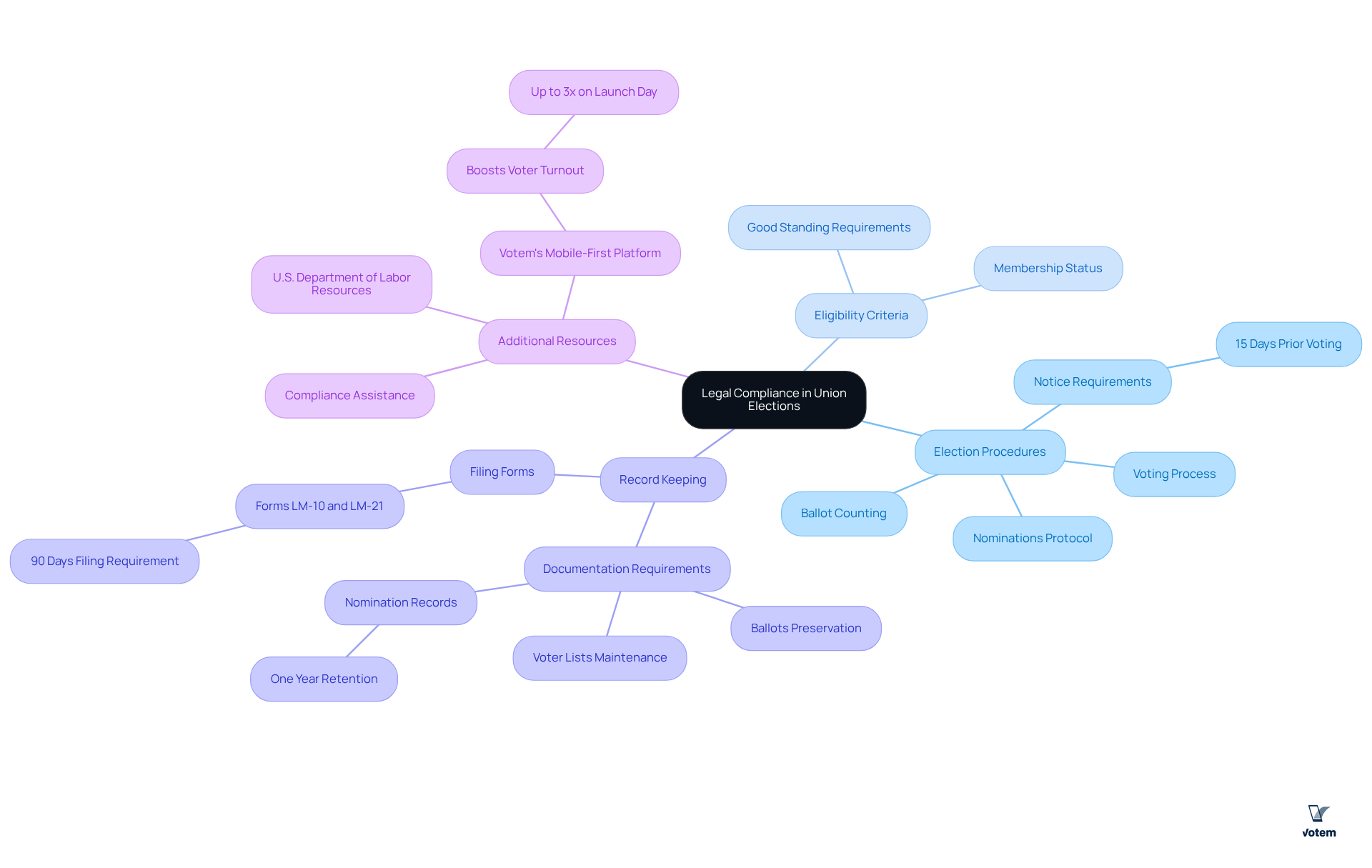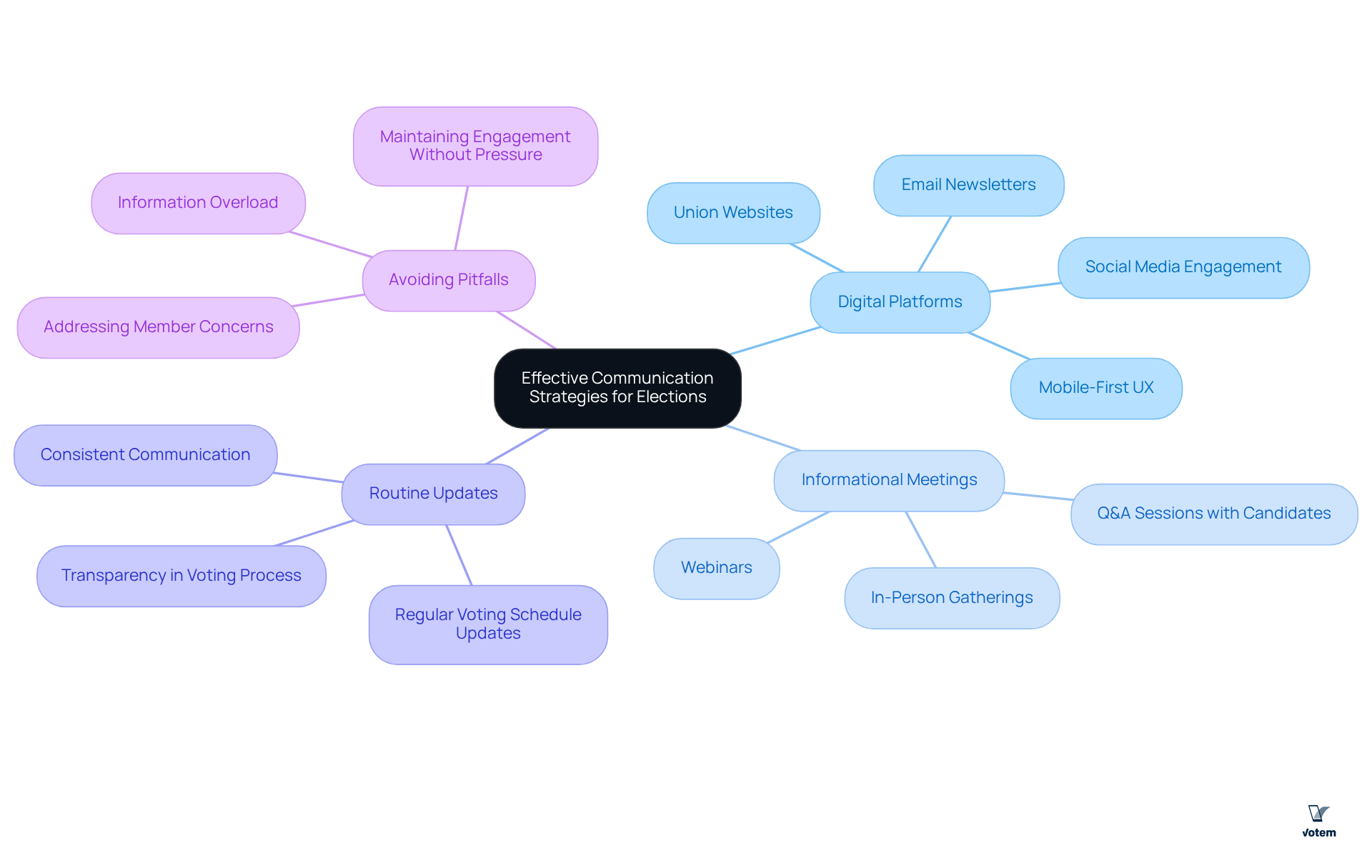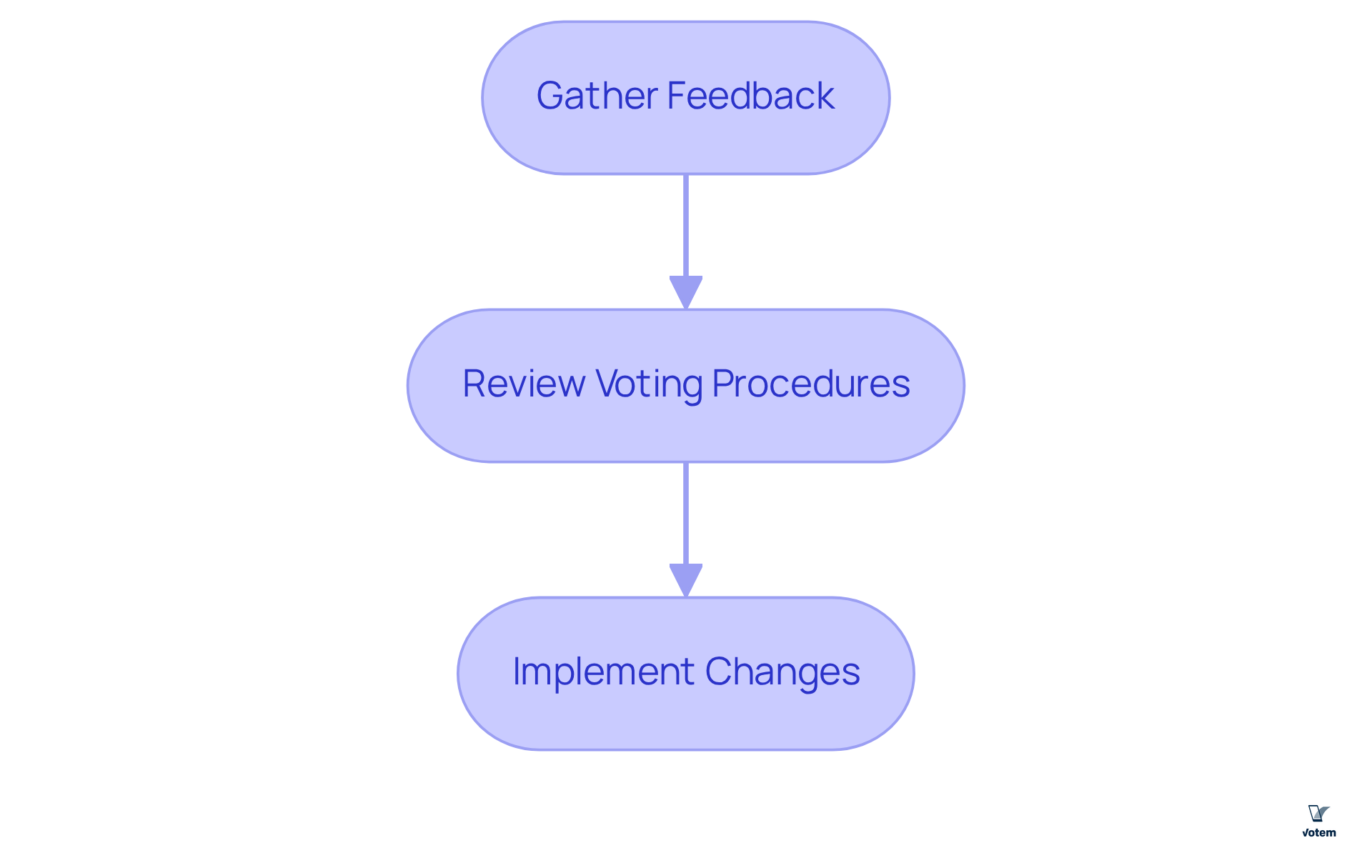Overview
The article outlines essential strategies for ensuring compliance and engagement in the re-election of union leaders, highlighting the necessity of understanding legal frameworks, effective communication, and the strategic use of technology.
First, it emphasizes key compliance requirements under the Labor-Management Reporting and Disclosure Act (LMRDA), which serve as the foundation for a successful electoral process.
Furthermore, it recommends employing multi-channel communication methods to significantly boost member participation, ensuring that all voices are heard.
In addition, the article underscores the advantages of secure online voting platforms, which enhance accessibility and can lead to increased turnout.
By leveraging these strategies, union leaders can foster a more engaged and compliant membership, ultimately strengthening their leadership and the union’s integrity.
Introduction
Navigating the intricate landscape of union elections demands a keen understanding of legal compliance alongside effective engagement strategies. Union leaders are confronted with the dual challenge of adhering to regulations while actively fostering member participation. The stakes for re-electing representatives have never been higher.
What innovative approaches can unions adopt to ensure compliance with the Labor-Management Reporting and Disclosure Act while also achieving a robust turnout among members?
This article delves into essential strategies that not only safeguard the electoral process but also invigorate member involvement, paving the way for successful union leadership elections.
Understand Legal Compliance in Union Elections
Union votes are governed by a framework of laws, notably the (LMRDA), which outlines essential processes for conducting ballots. Union leaders must possess a comprehensive understanding of these regulations to ensure compliance and maintain the integrity of the electoral process. Key components include:
- Election Procedures: Unions are mandated to follow specific protocols for nominations, voting, and ballot counting. This necessitates providing timely and adequate notice to members regarding the voting procedure, fostering transparency and participation. Importantly, votes must occur at least 15 days prior to the voting date, as stipulated by federal law.
- Eligibility Criteria: Clearly defining who is eligible to vote and run for office is vital. Typically, this encompasses conditions related to membership status and maintaining good standing within the organization.
- Record Keeping: Accurate documentation of the voting process is crucial. This includes preserving ballots, voter lists, and other pertinent records to ensure transparency and accountability. Union leaders are also required to maintain all nomination records for a minimum of one year, in accordance with federal law. Additionally, Forms LM-10 and LM-21 must be filed electronically within 90 days following the end of the fiscal year, which is critical for compliance.
For comprehensive guidance, resources from the U.S. Department of Labor offer invaluable checklists and compliance assistance tailored specifically for labor organization voting processes, aiding leaders in effectively navigating the complexities of legal requirements. Moreover, utilizing technology, such as Votem’s mobile-first platform, can significantly enhance voter engagement, potentially increasing turnout by up to three times on launch day. Understanding the potential consequences of non-compliance with LMRDA regulations is essential for leaders to avoid common pitfalls. Successful case studies also provide practical insights into effective labor organization voting strategies.

Implement Effective Communication Strategies
To maximize member engagement during elections, unions must implement a multi-channel communication strategy focused on re electing that captures attention and drives participation.
Utilize Digital Platforms: Leverage social media, email newsletters, and union websites to disseminate critical information regarding the election process, candidates, and voting procedures. Digital mobilization significantly enhances reach and visibility, leading to increased participation. As Sarah Lee aptly states, “Digital mobilization provides various advantages for unions, such as expanded reach and visibility, improved engagement and participation, better communication and coordination, greater flexibility and adaptability, and cost-effectiveness.”
Host Informational Meetings: Organize gatherings or webinars that allow participants to learn about the voting process, pose questions, and meet candidates. This approach nurtures a sense of community and promotes involvement, as individuals feel more connected and informed.
Routine Updates: Maintain engagement by providing consistent updates throughout the voting process. Transparency regarding the voting schedule and procedures fosters trust and encourages voter participation. Research indicates that effective communication can boost turnout by up to three times on launch day, particularly when utilizing platforms like Votem’s mobile-first UX.
Furthermore, organizations must remain vigilant regarding potential pitfalls in their communication strategies, such as overwhelming members with information or failing to address their concerns. By employing these strategies and being aware of common errors, associations can cultivate an informed electorate capable of actively engaging in the voting process, ultimately yielding more successful outcomes in re electing their representatives.

Leverage Technology for Accessible Voting Solutions
Integrating technology into union elections significantly enhances both accessibility and security, which is crucial for re-electing candidates. Consider these best practices:
- Online Voting Platforms: Secure online voting systems that comply with legal standards are essential. Platforms like Votem’s CastIron facilitate remote ballot casting, enabling participants to conveniently submit their choices from any location. With over 13 million votes successfully managed, Votem exemplifies in handling large volumes of ballots.
- Mobile Accessibility: It is crucial to optimize platforms for mobile devices, allowing participants to cast their ballots via smartphones or tablets. This approach can substantially boost involvement, particularly among younger individuals who are adept with mobile technology. Some platforms report turnout increases of up to three times on launch day, underscoring the effectiveness of mobile participation in enhancing engagement.
- Accessibility Features: Incorporating features that support members with disabilities, such as screen readers and alternative text for images, ensures that all members can fully engage in the election process.
- Security Measures: Implementing robust security features, including cryptography to safeguard ballot secrecy, addresses potential concerns regarding online election security.
- Cost and Time Savings: Highlighting the financial and temporal advantages associated with online balloting serves as a compelling motivation for organizations to adopt mobile polling solutions.
By leveraging these technological advancements, organizations can foster a more inclusive and effective electoral experience, ultimately leading to increased turnout rates and re-electing individuals. The implementation of mobile electoral solutions has proven to enhance participation significantly, with some platforms indicating turnout increases of up to three times on launch day. This not only boosts engagement but also fortifies the democratic process within unions.

Conduct Post-Election Analysis for Continuous Improvement
Following the election, it is imperative to conduct a thorough analysis for continuous improvement.
- Gather Feedback: Solicit feedback from members regarding their voting experience. This can be achieved through surveys or informal discussions, yielding valuable insights into what worked effectively and what areas require enhancement.
- Review Voting Procedures: Analyze the voting process comprehensively, including communication strategies, voter turnout, and any issues encountered. Identify areas for improvement and document the lessons learned.
- Implement Changes: Based on the analysis, make necessary adjustments to the voting process for future events. This may involve refining communication strategies, , or revising procedures to ensure compliance.
By committing to a cycle of evaluation and improvement, unions can significantly enhance the integrity and effectiveness of their elections, especially in the context of re electing leaders, thereby fostering greater member trust and engagement.

Conclusion
Re-electing union leaders is a critical process that relies on a profound understanding of legal compliance, effective communication, and the integration of technology. Adhering to regulations such as the Labor-Management Reporting and Disclosure Act is essential for upholding the integrity of the electoral process. By establishing clear election procedures, eligibility criteria, and robust record-keeping practices, union leaders can cultivate a transparent environment that encourages member participation.
Key strategies for enhancing engagement encompass:
- Leveraging digital platforms for communication
- Hosting informational meetings
- Providing routine updates throughout the election cycle
These approaches not only inform members but also foster a sense of community and trust, which is vital for driving voter turnout. Furthermore, utilizing technology such as secure online voting systems and mobile accessibility can significantly boost participation rates, rendering the voting process more inclusive and efficient.
Ultimately, the dedication to continuous improvement through post-election analysis is paramount. By gathering feedback, reviewing procedures, and implementing necessary changes, unions can enhance the effectiveness of their elections and build greater member trust. This cycle of evaluation not only strengthens the democratic process within unions but also ensures that leaders genuinely represent their members’ interests. Engaging in these practices will benefit the current election while laying a solid foundation for future electoral success.
Frequently Asked Questions
What is the Labor-Management Reporting and Disclosure Act (LMRDA)?
The LMRDA is a framework of laws that governs union votes and outlines essential processes for conducting ballots, ensuring compliance and integrity in the electoral process.
What are the key components of legal compliance in union elections?
Key components include election procedures, eligibility criteria, and record keeping. Unions must follow specific protocols for nominations, voting, and ballot counting, define who is eligible to vote and run for office, and maintain accurate documentation of the voting process.
What are the election procedures unions must follow?
Unions must provide timely notice to members about the voting procedure, conduct votes at least 15 days prior to the voting date, and ensure transparency and participation throughout the process.
What eligibility criteria must be defined for union elections?
Eligibility criteria typically include conditions related to membership status and maintaining good standing within the organization for individuals who wish to vote or run for office.
Why is record keeping important in union elections?
Accurate documentation of the voting process is crucial for transparency and accountability. Unions must preserve ballots, voter lists, and maintain all nomination records for a minimum of one year as required by federal law.
What specific forms must unions file for compliance?
Unions are required to file Forms LM-10 and LM-21 electronically within 90 days following the end of the fiscal year to ensure compliance with federal regulations.
Where can union leaders find resources for compliance assistance?
Resources from the U.S. Department of Labor offer checklists and compliance assistance tailored specifically for labor organization voting processes, helping leaders navigate legal requirements.
How can technology enhance voter engagement in union elections?
Utilizing technology, such as Votem’s mobile-first platform, can significantly enhance voter engagement, potentially increasing turnout by up to three times on launch day.
What are the consequences of non-compliance with LMRDA regulations?
Understanding the potential consequences of non-compliance is essential for union leaders to avoid common pitfalls and ensure the integrity of the electoral process.
Are there examples of successful voting strategies for labor organizations?
Successful case studies provide practical insights into effective labor organization voting strategies, helping leaders implement best practices for their elections.
List of Sources
- Understand Legal Compliance in Union Elections
- OLMS (https://dol.gov/agencies/olms)
- Checklist for Conducting Local Union Officer Elections (https://dol.gov/agencies/olms/compliance-assistance/elections/checklist)
- Employer and Consultant Reporting (https://dol.gov/agencies/olms/compliance-assistance/employer-consultant-reporting)
- LMRDA — News & Updates — UFCW 3000 (https://ufcw3000.org/news/tag/LMRDA)
- Implement Effective Communication Strategies
- Digital Mobilization in Union Organizing (https://numberanalytics.com/blog/digital-mobilization-union-organizing)
- electionbuddy.com (https://electionbuddy.com/blog/2024/10/18/developing-labor-union-election-strategies)
- Rethinking Union Member Communication and Engagement – UnionTrack® (https://uniontrack.com/blog/rethinking-union-member-communication-and-engagement)
- UAW and AFA labor union wins tied to strong communication strategies (https://axios.com/2024/05/16/labor-union-wins-communication-strategy)
- The Business of Union Elections: A Comprehensive Guide (https://numberanalytics.com/blog/business-guide-to-union-elections)
- Leverage Technology for Accessible Voting Solutions
- Mobile voting is here and it is transforming democracy (https://euronews.com/my-europe/2024/08/05/mobile-voting-is-here-and-it-is-transforming-democracy)
- Farmers Cooperative Elevator Co. MN – Stock Quotes (https://farmerscoopelevator.com/markets/stocks.php?article=marketersmedia-2025-7-17-eligo-evoting-launches-low-coercion-and-verifiable-digital-voting-protocol-in-the-us)
- Advantages of online voting in union elections (https://kuorum.org/en/post/benefits-of-an-online-voting-tool-for-union-elections)
- ash.harvard.edu (https://ash.harvard.edu/articles/will-mobile-voting-defeat-gerrymandering-and-increase-participation)
- Electing Union Officers Using Remote Electronic Voting Systems (https://dol.gov/agencies/olms/compliance-assistance/tips/remote-electronic-voting-systems)
- Conduct Post-Election Analysis for Continuous Improvement
- Movement Advancement Project | Beyond the Ballot: Understanding Post-Election Processes in America (https://mapresearch.org/policy-and-issue-analysis/2024-beyond-the-ballot-report)
- Project 2025, Explained | American Civil Liberties Union (https://aclu.org/project-2025-explained)
- Post-Election Day Analysis | Burson (https://bursonglobal.com/insights/us/post-election-day-analysis)
- U.S. Postal Service Releases 2024 Post-Election Analysis Report Detailing the Successful Efforts Taken to Deliver the Nation’s Election Mail Securely and Effectively (https://about.usps.com/newsroom/national-releases/2024/1202-usps-releases-2024-post-election-analysis-report.htm)
- States United Action Releases Post-Election Analysis and 2025 Election Denier Landscape: Election Deniers Have Fewer Seats, More Power in 2025 – States United Democracy Center (https://statesunited.org/post-election-2024)

